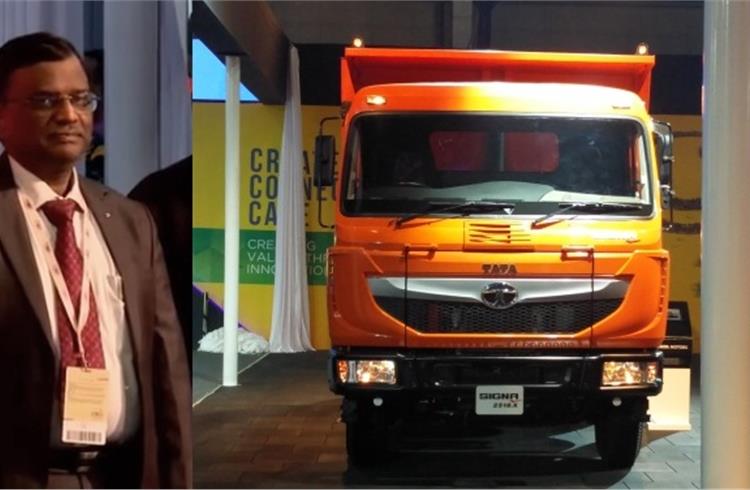‘By using high-strength steel, the new Signa M&HCV range benefits from weight savings ranging from 300kg to 1.5 tonnes.’
With the unveiling of its new Signa range of M&HCVs at the Auto Expo 2016, Tata Motors is all set to transform the mass-market segment in India. Dr AK Jindal, speaks about the development of the new truck range.
With the unveiling of its new Signa range of M&HCVs at the Auto Expo 2016, Tata Motors is all set to transform the mass-market segment in India by offering first-in-class features along with an emphasis on driver safety and comfort. Dr AK Jindal, Head of Engineering, Commercial Vehicles Business Unit, Tata Motors speaks to Shourya Harwani about the development of the new truck range.
Why was there a delay in the launching of the new Signa range?
I think the delay happened because we wanted to match and exceed the expectation levels of our customers. We really wanted to launch a matured product in the market and that took some time. The Signa was conceptualised two years ago and because it is based on our existing range, there was a lot of re-tooling and re-designing of components, which has taken some time.
Where would Signa fit in Tata Motors’ portfolio of M&HCVs?
This range will replace all the current models, apart from our Ultra and Prima ranges. It sits right in the M&HCV segment. In fact, at the lower end, the Signa series will almost converge with the Ultra range. Ultimately, we would want everything to migrate to the Prima range, but right now there is price sensitivity, and the Signa range has been designed so that price-conscious customers also get a refined yet cost-effective product.
When would be the Signa range commercially available in India?
Within the next quarter, you would see the Signa range being completely rolled out. It is a big segment spanning across products.
Have you used any new component suppliers for the Signa platform?
It has been done based on variants and requirements. By bringing everything under the Signa platform, we have incorporated all the learnings over the years that we have had. Our effort has been to use all our existing suppliers who have worked with us in the past, so those suppliers who have worked with us on the Ultra and the Prima have contributed on the Signa.
Signa is more accentuated by new features such as air-conditioning and other driver comforts, which were not present earlier. As the market is moving more now towards factory built vehicles, the Signa range will help in accelerating that process.
How important is lightweighting in the M&HCV industry now?
It is very important now. It is becoming very critical because more and more organised operators want better fuel efficiency and higher payload capacity. Apart from that, the contractors are also going by the rated payload and their contracts also depend on it. Obviously then, the rated payload becomes very critical and we are working diligently on how to reduce weight. Migrating towards rated payload has given us the opportunity to re-optimise, without losing durability. We are not eliminating any components, but just re-engineering them for optimal performance.
As regards the materials used in the Signa range, how different are they from the previous-generation Tata trucks?
Good question. For example, in the tipper load body, we have worked with Tata Steel to develop high-strength steel and the resultant weight saving ranges from anywhere between 300kg to 1.5 tonnes, which is significant weight reduction from the previous generation of our trucks. We have also saved weight on the chassis and the frames have also been re-optimised to save weight.
How does Tata Motors plan to meet the challenge of BS VI?
Obviously, it is a huge challenge. If we go by examples all over the world, nobody has been able to migrate from one emission cycle to the next in less than five years; even the last Euro 6 migration took six years. Of course, we need to crank up the whole system, not just Tata Motors but all the suppliers as well. Secondly, the most important thing is it is not that something is available and you just pluck it out and plant it here. We will have to do a lot of re-engineering. We need to have fit-for-market solutions and it will require a lot of effort and time.
Have you embarked on the process of re-engineering? What about availability of fuel for testing and are you confident of meeting the 2020 deadline?
Yes we have. We have no option but to meet the deadline. We have been given an assurance by the Cabinet and the ministers that BS VI fuel will be available, but yes we need the fuel earlier for testing. Going by the assurance, we are confident of meeting the deadline.
RELATED ARTICLES
BRANDED CONTENT: 'We aspire to be among the leading sensors and electro-mechanical products manufacturer'
P. Parthasarathy, Founder & Managing Director, Rotary Electronics Pvt Ltd shares the company's commitment and vision to ...
‘Big opportunity for startups lies in products in India’: Detlev Reicheneder
As electrification levels the playing field, the focus on tech and R&D to bring innovative products is the mantra for st...
'I hope my journey makes people say — I can do this too'
Ranjita Ravi, Co-founder of Orxa Energies — the maker of Mantis e-bikes — shares the challenges of building a startup an...





 By Shourya Harwani
By Shourya Harwani
 09 Feb 2016
09 Feb 2016
 4801 Views
4801 Views









